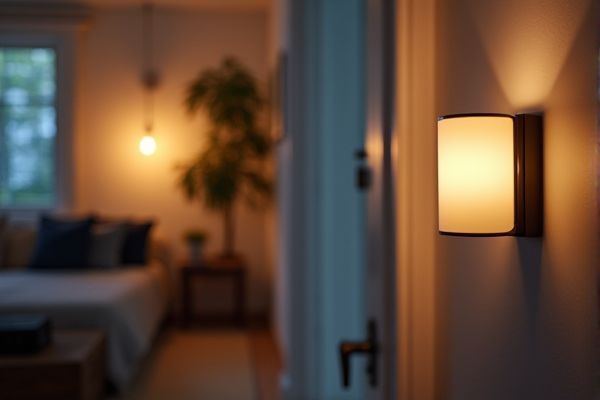
Lighting timers offer basic scheduling by turning lights on or off at preset times, providing energy savings and security, while smart lighting systems deliver advanced control with features like remote access, color adjustments, and automation through smartphone apps or voice commands. Discover how choosing between lighting timers and smart lighting can enhance Your home's convenience and efficiency by reading the rest of this article.
Table of Comparison
| Feature | Lighting Timer | Smart Lighting |
|---|---|---|
| Control Method | Manual or preset schedules | App-based, voice, remote control |
| Automation | Basic on/off scheduling | Advanced automation (sensors, geofencing) |
| Customization | Limited to timing | Color, brightness, scene settings |
| Integration | Standalone device | Works with smart home systems (Alexa, Google Home) |
| Energy Efficiency | Reduces usage by scheduled off times | Optimizes usage with sensors and adaptive settings |
| Installation | Simple plug and play | Requires app setup and pairing |
| Cost | Low upfront cost | Higher initial investment |
| Maintenance | Minimal | Updates and occasional troubleshooting |
Introduction to Lighting Timer and Smart Lighting
Lighting timers control when your lights turn on or off based on preset schedules, providing basic automation to save energy and enhance security. Smart lighting systems offer advanced features like remote control, voice activation, and customizable settings through apps, adapting to your lifestyle and preferences. Choosing between a lighting timer and smart lighting depends on whether you prioritize simple scheduling or comprehensive, intelligent lighting management.
How Lighting Timers Work
Lighting timers operate by automatically turning lights on or off based on pre-set schedules, using mechanical, digital, or programmable systems to control electrical circuits. These devices enhance energy efficiency and convenience by eliminating the need for manual operation, typically programmed to follow daily or weekly routines. Unlike smart lighting, lighting timers lack remote control or automation features linked to sensors and mobile apps, focusing solely on scheduled timing functions.
Understanding Smart Lighting Technology
Smart lighting technology integrates timers, sensors, and connectivity to automate and customize lighting based on user preferences and environmental conditions. Unlike traditional lighting timers that operate on fixed schedules, smart lighting systems adapt dynamically through apps, voice control, and motion detection, enhancing energy efficiency and convenience. Understanding protocols like Zigbee, Z-Wave, and Wi-Fi is essential to optimize compatibility and functionality in smart home ecosystems.
Key Differences Between Lighting Timer and Smart Lighting
Lighting timers operate on preset schedules to turn lights on and off, offering basic automation for energy savings and security. Smart lighting systems provide advanced control through smartphone apps or voice commands, enabling customization of brightness, color, and integration with other smart home devices. You can optimize convenience and energy efficiency by choosing smart lighting over traditional timers, which lack dynamic adaptability and remote access.
Energy Efficiency Comparison
Lighting timers offer basic energy efficiency by automatically turning lights off after preset intervals, reducing unnecessary power consumption. Smart lighting systems provide advanced energy savings through adaptive controls, motion sensors, and real-time scheduling optimized via smartphone apps or voice commands. Studies show smart lighting can reduce energy use by up to 50% compared to traditional timers, making them more effective for long-term energy management.
Installation and Setup Process
Lighting timers typically offer straightforward installation with simple wiring to existing fixtures and basic programming for scheduled on/off times. Smart lighting systems require connecting to a home Wi-Fi network and configuring through a mobile app, enabling customizable scenes, remote access, and voice control integration. While lighting timers excel in ease of setup, smart lighting requires more initial configuration but provides greater flexibility and automation options.
Control and Customization Features
Lighting timers offer basic control by allowing you to schedule on/off times but lack advanced customization options. Smart lighting provides enhanced control through smartphone apps or voice commands, enabling you to adjust brightness, color, and set complex routines based on your preferences. For greater flexibility and tailored lighting experiences, smart lighting surpasses traditional timers in functionality.
Cost Analysis: Upfront and Maintenance
Lighting timers typically have lower upfront costs, ranging from $10 to $30, with minimal maintenance required beyond occasional battery replacement or manual adjustments. Smart lighting systems often involve higher initial expenses, averaging $50 to $200 per unit, depending on features like Wi-Fi connectivity and app integration, but offer remote control and automation that can reduce energy costs over time. Maintenance for smart lighting may include software updates and potential compatibility upgrades, which can increase long-term costs compared to the simpler, more durable lighting timers.
Suitability for Different Home Environments
Lighting timers provide a simple and reliable solution for homes seeking scheduled control of lighting without the complexity of network connectivity, making them ideal for aging populations or minimal-tech households. Smart lighting systems offer enhanced adaptability for modern, connected homes by allowing customizable settings, remote access, and integration with other smart devices through Wi-Fi or Bluetooth. The choice depends on the home's technological infrastructure and user preferences for convenience, automation, and energy efficiency.
Choosing the Right Solution for Your Needs
Lighting timers provide a reliable, cost-effective way to automate lighting schedules without requiring internet connectivity, ideal for simple setups and energy savings. Smart lighting systems offer advanced features such as remote control, customizable scenes, and integration with voice assistants, suited for tech-savvy users seeking convenience and flexibility. Assess your budget, desired control level, and compatibility with existing devices to choose between basic timers and fully programmable smart lighting solutions.
 homyna.com
homyna.com